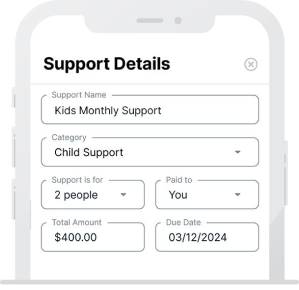Child Support is such a loaded term. What does it actually mean? What does it legally entail? Many people see child support as the Webster’s defined term, which is the amount of money that the non-custodial parent gives to the custodial parent to pay for a child’s basic needs. Child support technically is determined by the courts using calculators to estimate amounts, and is ruled into a court order. So one would be led to believe that the court ordered amount equals the child support payment, and that’s all there is to it.
The non-custodial parent pays their court appointed amount each month for basic needs such as food, clothing, and shelter. Meanwhile, the custodial parent is keeping track of all the extra things that cost beyond that, and will be letting the non-custodial parent know that they need more money to help with those costs. This can lead to a lot of distress and mistrust because the non-custodial parent is wondering where their money is going. Why isn’t the court appointed amount enough? The custodial parent should be keeping record of everything! Receipts, bills, transactions, anything related to the children, so that they can show the actual costs behind the requests.
Child Tax Credit
The child tax credit is an important tax relief option for parents, aimed at lowering their taxable income. This credit offers financial support to families raising children by directly reducing the taxes they owe. Eligible families can receive up to $2,000 for each qualifying child, with as much as $1,400 of that amount being refundable, which means you could get a refund even if you don’t owe any taxes.
In addition to the child tax credit, parents might also be eligible for the earned income tax credit (EITC). This separate credit is designed to offer financial support to lower-income families. The EITC depends on your earned income and can help lower your taxable income, which may lead to a bigger tax refund.
Both of these credits are designed to ease the financial burden of raising children, helping parents cover essential expenses like childcare, education, and healthcare. By understanding how these credits work and ensuring you meet the eligibility requirements, you can maximize your tax benefits and ensure your family’s financial stability.
Non-Custodial Parent Tax Credit
For noncustodial parents, claiming tax benefits related to their children can be complex, especially after a divorce or separation. Typically, the custodial parent is the one entitled to claim the child as a dependent, but noncustodial parents may be able to claim certain tax credits, such as the Child Tax Credit, under specific circumstances.
In situations where parents are separated, the noncustodial parent may claim the child as a dependent if both parents provide written consent and submit the appropriate forms to the IRS. This arrangement should be specified in the divorce or custody agreement, and the noncustodial parent must fulfill the IRS criteria for dependency claims.
The noncustodial parent may also qualify for additional tax credits like the Earned Income Tax Credit (EITC) or the Child and Dependent Care Credit, depending on their financial situation and how much support they provide.
To claim a child as a dependent, separated parents must ensure their agreement aligns with IRS rules. In cases where one parent has primary physical custody, they are typically the one eligible to claim the child as a dependent. However, if parents have joint custody or share time equally, they may need to make specific agreements about who will claim the child.
Consulting a tax professional can help navigate the legal and financial complexities of this process, ensuring that both parents understand their rights and obligations. By understanding these rules, the noncustodial parent can maximize their tax benefits while staying compliant with tax laws.
Tax Benefits for Divorced or Separated Parents
When parents are legally separated or divorced, the tax benefits associated with their children can get a bit tricky. Generally, only one parent is allowed to claim the child as a dependent on their tax return. However, both parents might qualify for different credits, like the Tax Credit or Earned Income Tax Credit, based on their individual situations.
For divorced or separated parents, deciding which parent can claim the qualifying child usually hinges on the custody arrangement, the level of support given, and the child’s residency status. If both the custodial and non-custodial parents come to a written agreement, the non-custodial parent might be able to claim the child, potentially lowering their taxable income.
It’s important for divorced or separated parents to understand the rules surrounding these credits and consult a tax professional if necessary to avoid mistakes. Each parent’s situation is unique, and keeping track of these tax implications can ensure that both parties are maximizing their benefits while staying compliant with the law.
Noncustodial Parent and Tax Implications
- Taxable Income: The noncustodial parent can still be eligible for various tax deductions or credits, even if the child does not live with them all the time. Understanding the impact of these on your taxable income is important.
- Tax Year: When determining eligibility for tax benefits, the tax year is important. The parent claiming the child must have them for more than half of the year, unless otherwise agreed upon or specified by the Internal Revenue Code.
- Internal Revenue Code: The Internal Revenue Code lays out specific rules regarding dependents. Noncustodial parents must follow these regulations when claiming a child for tax purposes, as it determines eligibility for credits like the child tax credit.
- Child Lives: In general, the parent with whom the child lives for the majority of the year is eligible to claim them as a dependent unless a special agreement is in place that shifts the right to the noncustodial parent.








